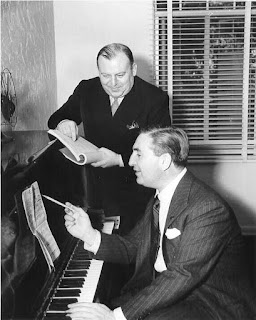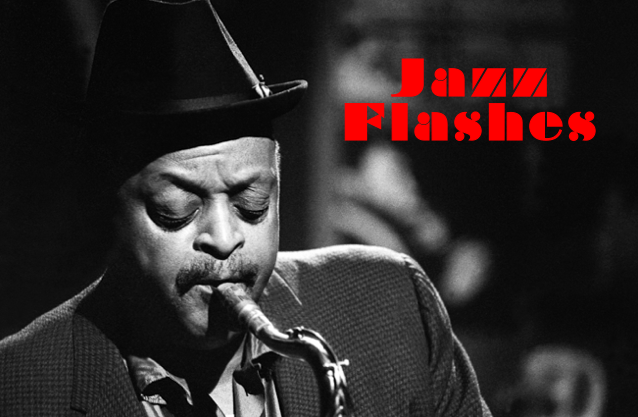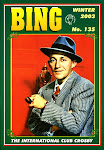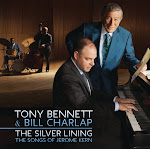 |
| George and Ira Gershwin |
The Vintage Bandstand: In your very insightful chapter on Ira Gershwin, you observe that “what really interested him was less the romantic message than the medium of language itself—the vocabulary, idioms, and phrasing of American speech.” While I completely agree with that statement, it makes me wonder—isn’t that the case with every lyricist whose work you examine in your study? Or do you think that this concern with language is more obviously acute in the lyrics of Ira Gershwin?
Mr. Furia: Hmmm. This one made me really think. Let’s go back to an earlier question about the difference between poetry and lyrics. When we read a lyrical poem, such as Yeats’ “Easter 1916,” we assume that Yeats is writing about what he deeply feels about something that has happened to him. When Ira Gershwin writes “Someone to Watch Over Me” (1926), we don’t feel he is writing about his personal feelings or experience, however much he may share the lyric’s longing to be loved and protected. Songwriters of this era, like the troubadours of Provence, were ringing changes on a handful of romantic themes—falling in love at first sight, cataloging the beauties of their beloved, suffering the anguish of romantic rejection. Occasionally, a song such as the current hit, “Someone Like You,” may register the songwriter’s own personal romantic agony, but for the most part, particularly in the Golden Age, songwriters were understood to be crafting variations of a few romantic themes that had only remote resonance with their personal lives.
Yet in crafting those variations, some lyricists emphasized romantic passion, heartache, and euphoria in a wider variation more than did others. Hart, Berlin, Mercer, and Porter seem to me the lyricists with the greatest emotional “range,” from the ecstasy of “Wait Till You See Her” to “Nobody’s Heart”—to take two examples from some of Hart’s final songs in 1942, a year before his death. Other lyricists seem to treat romance playfully—but no less brilliantly. Here I’d place Ira Gershwin and Yip Harburg, who met in high school and remained lifelong friends. Ira wrote almost no lyrics of burning passion or wrenching romantic heartache until, late in his career, he wrote “The Man That Got Away” (1954) with Harold Arlen. Same with Yip Harburg, whose “Last Night When We Were Young” (1936, also with Arlen) was a rare but moving plunge into the depths. Both “Yip” and “Gersh,” as they nicknamed themselves in high school light verse, reveled in linguistic playfulness: Ira rhyming “You say ‘either,’ and I say ‘eye-ther'"; Yip twisting words in “I simply relish this swellish condish.” In such lyrics, it seems to me the linguistic play upstages the romantic passion.
TVB: The foremost lyricists of the golden age became masters at “saying ‘I love you’ in thirty-two bars,” to use your quotation from the biopic of Gus Kahn. However, as you point out in your book, many of them often depicted love in their songs from a markedly anti-romantic perspective. How do you explain this lyrical phenomenon?
Mr. Furia: Playing off my answer to the previous question, “saying ‘I love you’ in thirty-bars” meant finding new twists to the standard romantic themes of longing for love, falling in love, and losing love. A good lyricist always handled these standard situations with a clever twist, frequently a seemingly anti-romantic twist. Ira Gershwin describes a man’s reaction o his first passionate kiss with something we say when find our lover in bed with someone else: “How Long Has This Been Going On? (1928)” He and Yip Harburg wrote a song in 1934 called “What Can You Say in a Love Song (That Hasn’t Been Said Before)?” And what lyricists came up with was often unromantic, such as Larry Hart’s saying in “My Funny Valentine” (1937), “Your looks are laughable, unphotographable . . . “ or Cole Porter saying, “It’s the wrong time, it’s the wrong place, though your face is charming it’s the wrong face . . . but it’s all right with me” (1953). The best twist a lyricist could give to saying “I love you” was to say it unromantically
TVB: In your chapter on Howard Dietz and Yip Harburg, you note that Harburg was “deeply political.” We can clearly see that in his excellent lyric to “Brother, Can You Spare a Dime?” However, not too many lyrics from the golden age are overtly political. Why do you think that is the case, especially at a time when the United States were going through a harsh economic depression?
Mr. Furia: Another good question that I’ve thought about for years. You had political songs in the nineteenth century and certainly since the rise of rock and folk music in the 1950s and ‘60s, but very few in the Golden Age (Harburg’s “Brother, Can You Spare a Dime?” from 1932, always the exception that proves the rule). I think it goes back to the fact that most popular songs in this era came from Broadway and Hollywood musicals. With a few exceptions, such as “Ol’ Man River” from Show Boat (1927), these musicals were not overt political vehicles, and they called for frothy songs about love that suited their boy-meets-girl stories. I’m not a cultural historian, but my guess is that their apolitical nature also suited what radio stations wanted to play. The few musical films and shows that offered more political fare, such as Hallelujah! I’m a Bum (1933) and The Cradle Will Rock (1937), produced virtually no hit songs. While some songwriters, such as Woody Guthrie, were writing political protest songs, what most people listened to were the songs of Cole Porter and Irving Berlin, who even took heat in 1938 when he updated an old World War I song, “God Bless America,” for presuming, as a Jewish immigrant, to speak for America on the brink of World War II. Lyricists did much to look at depression tangentially in romantic lyrics such as Ira Gershwin’s “Things Are Looking Up” and “Nice Work If You Can Get It” (1937).
TVB: Though Irving Berlin, Cole Porter, the Gershwins, Rodgers & Hart, and Harry Warren, Al Dubin, and Mack Gordon graced movie musicals with some memorable songs, many composers and lyricists felt deeply constrained and unhappy in Hollywood. Why was the movie industry so reluctant to transpose Broadway musicals onto the screen? In retrospect, it seems that a good opportunity for the creation of great songs was wasted in most movie musicals whose plot revolved around the production of a musical. Don’t you think that the inherent metafictional nature of such films could have spawned some interesting songs on the subject of songwriting itself?
 |
| Al Dubin and Harry Warren |
When they went out to Hollywood after sound came to the movies, a very different system was in operation—one that pushed songwriters to the sidelines. They had little say in how their songs were used and sometimes only given the outline of a screenplay to work with. They were simply expected to “write hits” that would earn additional money for a film. “Out here,” composer Harry Warren observed of Tinseltown, “songwriters were the lowest form of animal life.”
As I said earlier, Hollywood at first worried that audiences would find it ludicrous if characters suddenly burst into expressive song then went back to dialogue. Therefore early movie musicals were “back-stagers” in which characters portrayed singers and dancers putting on a stage musical. When they sang, it was because they were rehearsing or performing a song before an on-screen audience. The songs they usually sang were the pop hits of the day. For example, when Jolson sang Irving Berlin’s “Blue Skies” in The Jazz Singer in 1927, the song had already been a big hit from the previous year.
Realizing that they would need lots of songs for such back-stagers, Hollywood studios bought out the catalogs of the old Tin Pan Alley sheet-music publishing firms and moved their composers, lyricists, and arrangers to the West Coast. Old songs could be recycled into new films and become money-making hits (which is what “As Time Goes By,” a song by Herman Hupfeld from 1931, did when it was inserted into Casablanca in 1942). When a studio did a film version of a Broadway musical, they frequently gutted all or most of its songs and had their in-house songwriters write new songs which the studio owned and could make money on. Occasionally, a song from a Broadway show was so well-known that the movie had to keep it (and pay for it). Cole Porter’s “Night and Day” was so famous that the musical it came from, The Gay Divorce (1932), was referred to as “The ‘Night and Day’ show.” When RKO did a film version of the show, they had to keep “Night and Day,” but they threw out all of Porter’s other songs and added new ones to the score. They also had to change the title of the show to The Gay Divorcée. It was 1934, the year the censorship “Code” came into force, and, while divorce could never be gay, a divorcée could since musicals had long before proved that even a widow could be merry.
To answer the last part of this question, a few of the early back-stager musicals did portray the creation of songs for a show, such as Lord Byron of Broadway (1930), but the films were generally so unimaginative that these opportunities were squandered. Even when Hollywood started making “biopics” about songwriters, such as Rhapsody in Blue (1945) and Night and Day (1946), the “inspiration” scenes for songs are frequently ludicrous. An exception is the scene where James Cagney, portraying George M. Cohan in Yankee Doodle Dandy (1942), writes “Mary’s a Grand Old Name.” Such songs still fall within the “performance” convention of presenting song in film. That convention, however, robs song of its expressive power. As I said earlier, when characters sing in opera, operetta, and stage musicals, they are not “performing” a song but, in the context of character and story, expressing what they feel at a heightened dramatic moment. That kind of expressive song only entered film in the early 1930s and largely disappeared by the 1960s. The few movies that tried to present songs expressively, such as At Long Last Love (1975), bombed with audiences, who had come to view characters in movies breaking into song as ludicrous. The only exceptions to that lost convention were cartoon musicals, musicals aimed at children, such as Mary Poppins (1964), and movies that were film adaptations of Broadway musicals. Only in these cases do contemporary movie audiences allow characters to sing expressively. In all other movies, a song must be presented as a performance—just as in the earliest days of film musicals.
 |
| Hoagy Carmichael at the piano |
Mr. Furia: Since I’m not a lyricist, this is only speculation, but I imagine that there is virtually no collaboration between composer and lyricist when words are set to a jazz instrumental. Even though the music came first in other collaborations, composer and lyricist were usually in the same room together sweating out the lyric. The toughest thing for a lyricist, I imagine, is trying to hear what the music is “saying”—what latent emotional meaning lies in those abstract musical notes and phrases, rhythms and harmonies, that must be made articulate in words. There are several stories about the Gershwins, Dietz and Schwartz, and other collaborators in which the lyricist has asked the composer to slow a sprightly melody down to a languid ballad to suit the emotional contour of a lyrical idea. That kind of interplay usually didn’t happen when a lyricist added words to an existing jazz instrumental. With the great lyricists, of course, there sometimes didn’t need to be. In 1954, when Johnny Mercer heard Lionel Hampton and Sonny Burke’s “Midnight Sun” on his car radio as he drove along a California freeway, he was so taken with the instrumental that he pulled into a gas station, called the radio station on a pay phone (these were the days before cell phones), and asked them to play the song again. On just this second hearing, Mercer came up with a seamless, sensuous lyric, and he claimed the first thing that came to him were those opening feminine rhymes—“palace,” “chalice,” “aurora borealis.”
I suspect another problem is the lack of what Ira Gershwin called “particularity.” Jazz instrumentals were not written for a Broadway or Hollywood musical so there is no character or dramatic situation to help a lyricist come up with a new way to say “I love you.”
TVB: Besides The Poets of Tin Pan Alley, you have written whole books about Johnny Mercer, Irving Berlin, and Ira Gershwin. What was it about those lyricists that drew you to study their lives and careers more in depth? Are you currently planning or working on any further similar studies?
Mr. Furia: I wrote the book about Ira Gershwin right after The Poets of Tin Pan Alley. I wanted to look at one of those lyricists in depth, and Ira seemed a good choice. He’d had a fairly long collaboration with his brother but then wrote with a variety of other composers—Kern, Arlen, Weill—each with a very different musical style. He’d also worked with equal success on Broadway and in Hollywood. And he’d also written a lot about the art of lyric writing, especially in his wonderful anecdotes about his own songs, Lyrics on Several Occasions (1959). By sheer luck, the Gershwin family had just created an archive of the papers of the Gershwin brothers in Beverly Hills, so I got to be one of the first to work on that huge collection of manuscripts and other materials. Sheldon Meyer, my editor at Oxford, was enthusiastic when I proposed the idea for the book, so I could easily “get started.”
I had started working on another book for Oxford, about Hollywood lyricists, when another editor, from Simon & Schuster/Schirmer, approached me about doing a book for a series they were starting about popular song composers. I said I’d be interested but that it would have to be a composer who was also a lyricist. That pretty much meant Berlin or Porter, and I thought I’d be better able to follow Berlin’s music than Porter’s (though I still had to bring in a former music graduate student I’d taught at Minnesota, Graham Wood, to help me with the musical analyses). Berlin was also a good choice because his extensive manuscripts, scrapbooks of newspaper articles and interviews, and correspondence was just then being catalogued at the Library of Congress, so I was, again, one of the first to work on that collection. When I was writing The Poets of Tin Pan Alley, I was fortunate to be one of the few writers to receive permission to quote from Berlin’s song lyrics. Berlin was his own music publisher, so he owned the copyrights to his songs (unlike most other songwriters). He and his assistants were notorious for refusing—sometimes angrily so—to allow anyone to quote from his works. But his attorney read my chapter on his songs in The Poets of Tin Pan Alley and went to bat for me, so I was pretty sure I could get permission to quote from his songs. Finally, a colleague here at the University of North Carolina Wilmington turned out to be a friend of Mary Ellin Barrett, Berlin’s oldest daughter, and put me in touch with her. She is a writer herself and was enormously helpful.
The only downside to the Berlin book was that Sheldon Meyer, my editor at Oxford, felt betrayed that I had gone with another publisher and halted work on the book on Hollywood lyricists. We mended fence after the Ira Gershwin book did well, and the Gershwin family invited me and my wife to the big centenary celebration for Ira at Carnegie Hall, which Sheldon and his wife also attended.
 |
| Songwriter and singer Johnny Mercer |
Two years ago, after more than fifteen years of research, I completed the book on Hollywood lyricists, though by then it had expanded to include how songs were presented in all movies—not just musicals but dramatic films as well. My wife, Laurie Patterson, and I watched more than a thousand movies, many in film archives at UCLA, the Library of Congress, and the Wisconsin Film Archive. Our co-authored book, The Songs of Hollywood, came out in 2010 from Oxford University Press. Although Sheldon Meyer, by then retired, died before its publication, he knew it was finally coming out.
Right now I don’t have another book in progress but for the last couple of years I’ve been doing a series of short programs for our local public radio station. It’s called The Great American Song Book and each day I take one of the classic standards, talk about how it was written, why it’s so good, and tell an amusing or poignant story associated with the song. Then we play two versions of the song—a classic rendition by Sinatra, Ella, or another period singer, then a contemporary version by Rod Stewart, Willie Nelson, or the Supremes. I’ve been thinking about ways of turning these programs—now more than two hundred of them—into a book. If I do, I’m going to dedicate it to the memory of Sheldon Meyer.
 |
| Philip and his wife, Laurie (Photo: Jamie Moncrief) |






























No comments:
Post a Comment